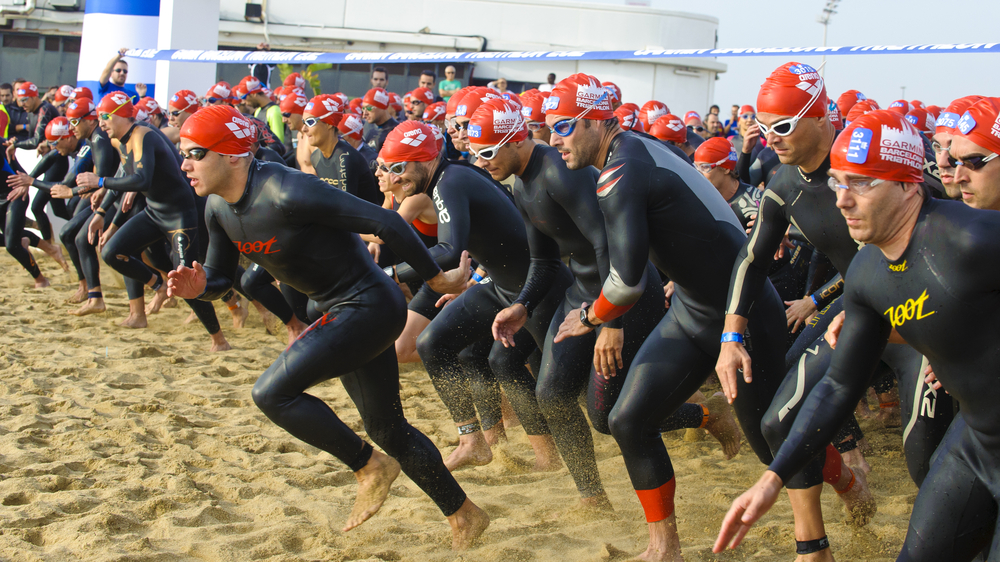Triathlons are made up of 3 specific exercises. These are swimming, cycling, and running and are typically performed in this order. Some triathlon organizers will switch up the order, or substitute kayaking for swimming, but this is uncommon.
An Olympic triathlon incorporates a 0.9 mile (1.4 km) swim, a 25 mile (40 km) cycle, and a 6.2 mile (10 km) run. This can be intense if you are not at a good fitness level. There are also sprint and super-sprint triathlons. These are much shorter and tend to only take up to 2 hours to complete.
This means that even as a beginner, you can compete in and complete a triathlon. There are many websites that you can use to find a suitable race to enter. We recommend TriFind, which will help you to find triathlons in your state.
You should focus on training for your transitions too. These are the periods between each of the 3 sports when you switch from one to another.
You will need to ensure everything is set up correctly and is easily visible. This will help to make for a fast changeover and a shorter overall triathlon time.

Can a beginner do a triathlon?
Yes, a beginner can do a triathlon. It will be difficult as you are starting from a lower fitness level and the race is very testing.
We recommend starting with a sprint or super-sprint triathlon as these will be much easier for you to complete. Starting with a full triathlon could lead to you developing injuries that will put you out of action for extended periods of time.
As a beginner, it is often a good idea to try and join a triathlon club. These will host weekly training sessions to get you into shape for the race and to keep you motivated on your fitness journey.
We recommend purchasing the basic kit for triathletes as you go along in your training. You will need a bike, a cycling helmet, running shoes, and swimming goggles at a minimum. As you get better at the sport, upgrade to items such as wetsuits, aero bars, and workout clothing.
How do I train for a triathlon in 4 weeks?
It will be difficult to train for a triathlon in 4 weeks, but it is not impossible. The training plan laid out below is the best way to optimize your personal fitness in time for the race. If you are unfit to begin with, we recommend consulting with a doctor before putting your body through this.
Week 1 | Week 2 | Week 3 | Week 4 | |
Monday | 10 lots of 50m front crawl swim, with 30 seconds rest between | 25 minute outdoor cycle, 10 minutes easy, 10 minutes hard, 5 minutes easy; 10 minute jog immediately after | 25 minute outdoor cycle, 10 minutes easy, 10 minutes hard, 5 minutes easy; 10 minute jog immediately after | 35 minute cycle, predominately at an easy pace; followed immediately by a 10 minute jog |
Tuesday | 15 minute run - 5 minutes jogging, 5 minutes sprinting, 5 minutes jogging | 20 minute jog | Rest day | Rest day |
Wednesday | 6 lots of 100m front crawl swim with 45 second rests between | 3 lots of 200m front crawl swim with 60 second rests between | 40 minutes easy cycling followed by 10 minute jog immediately after | 750m front crawl swim, no breaks |
Thursday | 25 minutes cycling outdoors, 10 minutes easy, 10 minutes hard, 5 minutes easy | 35 minute easy cycle | 2 lots of 300m front crawl swim with 60 second rests between | 20 minute run at a moderate pace, incorporating 3 minutes of sprints |
Friday | Rest day | Rest day | Rest day | 30 minute cycle at an easy pace, with 5 minutes of high intensity |
Saturday | 30 minute relaxing cycle | Easy 5k run | 20km cycle at moderate intensity; followed immediately by 10 minute jog | Rest day |
Sunday | 20 minute jog | 20 minute outdoor swim, focus on starts and exits | 20 minute outdoor swim with no rests, at moderate intensity, focus on starts and exits | RACE DAY |
How do you plan a triathlon training schedule?
There are 5 key steps that you should take when planning a triathlon training schedule. The first is setting your training volume, followed by the number of workouts and the length of each.
You should set out specifics for each workout and log them into your calendar so that you cannot avoid the plan.
Your training problem should be ambitious but should begin from a level that you can handle. If you are used to running 3 times a week, start from here. If you have had some time off of exercise, scale it back from the point you last reached.
You should include recovery weeks in your training schedule. Have at least one recovery week per month, where you drop your training frequency. If you are older than 40, we recommend taking a recovery week once every 3 weeks.
As you are planning for a triathlon, you should gradually increase your number of training hours each week. Do not increase by more than 20% in a week.
As a beginner, you should opt to perform more frequent, shorter workouts. This is particularly useful if there is a specific area of the triathlon that you are weaker in. If you wish to build up your endurance, you should perform fewer but longer workouts.
You should split the number of workouts into 3 groups - one for running, one for swimming, and one for cycling. Set a duration for each one, we recommend switching between longer and shorter workouts.
When we talk about workout specifics, we mean ways to make them more intense. You can add weights to your running and cycling workouts, or swim in open water. Each will change the intensity and feel of your workout, making for a better training experience.
When putting the workouts into your calendar, ensure you do not clump them all together. Take care to spread them out evenly across the week and intersperse training and rest days.
